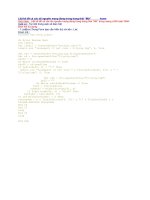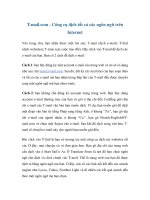Liệt kê tất cả các lỗi ngữ pháp cần tránh trong IELTS (writing task 1)
Bạn đang xem bản rút gọn của tài liệu. Xem và tải ngay bản đầy đủ của tài liệu tại đây (576.17 KB, 10 trang )
Website: vncourse.com
Blog: Thanhloanblog.com Page 1
Liệt kê tất cả các lỗi ngữ pháp cần tránh
trong Writing task 1
I. Lỗi ngữ pháp từ việc chấm bài các bạn học sinh khóa học
IELTS BEGINNERS
1. Đọc biểu đồ sai
Đọc hiểu sai yêu cầu của đề bài sẽ dẫn đến một loạt lỗi sai đi kèm phía sau trong bài viết,
sai tiêu chí task achievement nên các bạn tuyệt đối đừng vợi vàng trong quá trình đọc
hiểu đề bài. Ví dụ trong đề bài này không nói cụ thể về việc các nhóm đối tượng được so
sánh trên khía cạnh nào. Đề bài chỉ viết “The graph below gives information about the
preferred leisure activities of Australian children”
Kết quả là một bạn học sinh của mình đã viết như thế này “Australian youngsters spend
more time watching TV or videos than other activities”. Chú ý thông tin ở bảng là
“participation in….” và đơn vị là percent nên nó nói về phần trăm của trẻ tham gia vào
các hoạt động chứ không phải thời gian.
Website: vncourse.com
Blog: Thanhloanblog.com Page 2
2. Mệnh đề quan hệ
Các bạn thường bị sai ở mệnh đề quan hệ và việc rút gọn mệnh đề quan hệ rất rất nhiều
luôn. Chú ý như sau:
WHO làm chủ từ trong mệnh đề quan hệ thay thế cho danh từ chỉ người
… N (person) + WHO + V + O
Eg: The number of students who play videos games in their free time is highest.
WHICH làm chủ từ hoặc túc từ trong mệnh đề quan hệ thay thế cho danh từ chỉ vật
….N (thing) + WHICH + V + O
….N (thing) + WHICH + S + V
Khi rút gọn mệnh đề quan hệ
Dùng cụm Ving cho các mệnh đề chủ động
Eg: The number of students who play videos games in their free time is highest
= The number of students playing videos games in their free time is highest
Website: vncourse.com
Blog: Thanhloanblog.com Page 3
Dùng động từ ở dạng phân từ hai cho các mệnh đề bị động .
Eg: The house which was located in the north of the city in 2012 was knocked down to
make way for a new school.
= The house located in the north of the city in 2012 was knocked down to make way for
a new school.
3. Sử dụng thì
Lỗi sai thì sẽ dẫn đến mất điểm trong phần Grammar nên cũng cần phải note lại ở đây
nhé.
Với dạng có sự thay đổi theo thời gian
Tức là ở những biểu đồ này có thông tin về thời gian trong biểu đồ, bạn cần:
- Thời gian trong quá khứ, dùng quá khứ đơn
Eg: The number of students in school A was highest in the year 2010.
- Thời gian ở tương lai, dùng các cấu trúc miêu tả sự dự đoán
Eg: The number of students in school A is expected to reach its peak of 109 thousand in
the year 2050.
- Diễn tả xu hướng thay đổi chính kéo dài từ quá khứ đến hiện tại, dùng thì hiện tại
đơn.
Eg: The number of students in school A increases between 1950 and 2050.
Với dạng không có sự thay đổi theo thời gian
Nếu cả ở đề bài và biểu đồ đều không hề có thông tin gì về thời gian, hãy dùng thì hiện
tại đơn ví dụ như biểu đồ ở phần note 1
4. Sự tương ứng giữa các đối tượng so sánh
Website: vncourse.com
Blog: Thanhloanblog.com Page 4
Task 1 yêu cầu sự so sánh giữa các đối tượng trong biểu đồ nhưng các bạn lại thường viết
những câu mà các đối tượng so sánh không tương ứng
SAI: The number of students in class A is lower than class B
ĐÚNG: The number of students in class A is lower than that of class B
Ở đây hai đối tượng so sánh là “The number of students in class A” và “class B” là không
song song với nhau.
Hoặc các bạn cũng hay viết “The number of students reading books in their free time is
the most popular.” Cực kì khập khiễng vì chủ ngữ là số liệu, số liệu không thể “phổ biến
nhất” được. Thay vào đó các bạn cần viết:
SAI: The number of students reading books in their free time is the most popular.
ĐÚNG: The number of students reading books in their free time is highest
Reading books is the most favourite activity of students in the free time.
5. Dùng sai từ miêu tả số lượng
Amount/ quantity/ number
- Amount dùng với danh từ không đếm được
Eg: The amount of goods transported by road was highest
- Quantity dùng với cả danh từ đếm được và không đếm được
Eg: The quantity of students in class A was highest
“Number” được dùng cho danh từ đếm được số nhiều, và khi dùng từ này bạn cần lưu
ý về sự hòa hợp giữa chủ từ và động từ.
A number of + plural noun + plural verb
The number of + plural noun + singular verb…
Figure/figures: dùng để thay thế cho các đại lượng đã được nhắc đến trước đó
Website: vncourse.com
Blog: Thanhloanblog.com Page 5
Eg: In 1999, 35% of British people went abroad for their holidays, while only 28% of
Australians spent their holidays in a different country. The figure for the USA stood at
31%.
–> The figure = the percentage of the USA
Eg2: Around 40% of women in the UK had an undergraduate qualification in 1999,
compared to 37% of men. The figures for the year 2000 rose slightly to 42% and 38%
respectively.
–> The figures = the percentage of women + the percentage of men
The proportion/ percentage
Percentage: nghĩa là một phần trăm đã cho trên tổng số (thường là 100%).
The percentage of male students is 70%
Proportion: Một số lượng đã cho trên tổng số, có thể được dùng với cả phần trăm hoặc
số lượng của một nhóm– “proportion” mang ý nghĩa chung chung hơn so với
“percentage”
“the proportion of + plural noun”
Eg: The proportion of male students is higher than the proportion of female students.
6. Thiếu mạo từ
Mạo từ “the” trước một số nước
Một số nước là tổ hợp của nhiều bang hoặc nước nhỏ khác nhau (thường là những nước
có tên viết tắt) thì phải có mạo từ “the” đứng trước.
Ví dụ: In the UK, In the USA, In the US, not in UK, in USA
Không cần “the” trước tính từ so sánh hơn
Trong cấu trúc “The amount/number/proportion of …. + be + highest/largest/lowest”
không cần mạo từ “the” trước tình từ nữa vì thực ra là nó việc viết lại cụm “The +
highest/largest/lowest …+ amount/number/proportion” nên đã có mạo từ “the” ở trước đó
rồi.
Website: vncourse.com
Blog: Thanhloanblog.com Page 6
SAI: The number of students in 2012 is the highest
ĐÚNG: The number of students in 2012 is highest
“the” cần trước danh từ
Một số từ như “Most of / all of / the whole of…” thì bắt buộc phải có “the” đứng trước
danh từ đi theo nó để thể hiện một nhóm đã xác định chứ không chung chung.
SAI: Most of students read books in their free time.
ĐÚNG: Most of the students read books in their free time, at 67%.
All of the girls aged 5 to 14 watch TV in their free time.
II. Điểm ngữ pháp được chia sẻ bởi thầy Simon (ielts-simon.com)
1. IELTS Grammar: for band 7
I don't think that using 'difficult' grammar is the best way to get a band 7.
If you want a band 7, the most important thing is to be able to write error-free sentences.
If all of your sentences contain small mistakes, it's unlikely that you'll get a 7. It might be
better to take fewer risks with complex structures, and aim for more error-free sentences.
2. IELTS Grammar: using 'by'
A student asked me about the two uses of the word "by" in these sentences:
Korea was the only country that managed to reduce its waste output by the year 2000.
Korea cut its waste output by 12 million tonnes between 1990 and 2000.
Questions:
1. Can you explain how "by" is used in the two cases above?
2. What is the difference between "by the year 2000" and "in the year 2000"?
3. IELTS Grammar: nouns and verbs
Website: vncourse.com
Blog: Thanhloanblog.com Page 7
Sometimes the noun form and the verb form of a word are the same. For example, the
word “increase” can be a noun or a verb. The problem is that nouns and verbs are used
differently. Here are some examples:
Increase
There was an increase in the unemployment rate. (noun)
The unemployment rate increased. (verb)
Lack
There is a lack of investment in hospitals. (noun)
Many hospitals lack the investment they need. (verb)
Pay
Companies should give men and women equal pay. (noun)
Companies should pay men and women equally. (verb)
It's the little words like "an increase in" that cause most problems for students. Examiners
do notice these things, so it's worth getting them right.
4. IELTS Grammar: wide range or error-free?
A student, Kishanth, asked me about two of the points in the grammar criterion for band
8 writing (both task 1 and 2):
uses a wide range of structures
the majority of sentences are error-free
Here's the problem with these two points:
When you try to use a wide range of grammatical structures, you risk making more
mistakes (errors). But to reduce the number of mistakes, you might have to simplify your
sentences.
So what should you do?
Website: vncourse.com
Blog: Thanhloanblog.com Page 8
My advice is this: Forget about the 'wide range of structures' point. If all of your focus is
on using complex grammar, you'll probably do something worse than just make mistakes;
you'll probably forget to answer the question properly. The people who worry most about
grammar usually neglect task response, coherenceand vocabulary.
For me, grammar is the least important criterion to worry about. I tell students to focus on
the other 75% of the scoring system: task response, coherence and vocabulary. However,
if you want my tip for improving your grammar score, I'd say that it's better to focus on
reducing errors. I think examiners notice errors more than they notice grammatical range,
and if you write a mix of short and long sentences, you'll probably fulfil the 'wide range
of structures' requirement without realising it.
5. IELTS Grammar: be careful with the 's'
Notice where we put the "s" on the end of a word and where we don't:
Thousands of people watched the show.
Fifty thousand people watched the show.
over a period of ten years
over a ten-year period
The fish weighed 5 kilos.
It was a five-kilo fish.
The boy is three years old.
He is a three-year-old boy.
6. IELTS Grammar: using 'with' instead of 'and'
Here's a structure that my students found interesting:
A) The IELTS exam is popular, and over 1 million people take it every year.
B) The IELTS exam is popular, with over 1 million people taking it every year.
Website: vncourse.com
Blog: Thanhloanblog.com Page 9
A) The cost of living is high, and prices are going up every year.
B) The cost of living is high, with prices going up every year.
Notice the use of the 'ing' verb form after 'with'. Notice also that there is no auxiliary verb
'are' in the second example. To practise this type of sentence, try making an example of
your own!
7. IELTS Grammar: 'by/in contrast' and 'on the contrary'
A few people have asked me about these phrases recently. Do they have the same
meaning? When is each one used?
By contrast / In contrast
I often use these two phrases in both writing task 1 and 2. They are exactly the same, and
are used in a similar way to "however" or "on the other hand" to introduce a contrast /
comparison. Put "By / In contrast" at the beginning of a sentence, with a comma after
"contrast".
Example: Unemployment rose in the UK. By contrast, the number of unemployed people
in Canada fell.
On the contrary
I've never used this phrase in any of my IELTS lessons. It doesn't mean the same thing as
"by / in contrast". We use "on the contrary" to deny that something is true, and to explain
that the opposite is true.
Example
- Person 1: "You had some problems with your hotel, didn't you?"
- Person 2: "On the contrary, the hotel was great, but the airline lost my suitcase."
8. IELTS Grammar: fall or reduce?
These two words are the opposites of 'rise' and 'raise' (see last week's grammar lesson):
Website: vncourse.com
Blog: Thanhloanblog.com Page 10
something falls (e.g. the price fell)
somebody reduces something (e.g. the company reduced the price)
You will probably use 'fall' to describe numbers on a graph or chart for IELTS Writing
Task 1:
In 2008, the number of customers fell. (verb, past)
There was a sharp fall in Internet usage. (noun)
'Reduce' and 'reduction' are probably more useful for Writing Task 2:
We need to reduce the amount of pollution from exhaust fumes. (verb)









